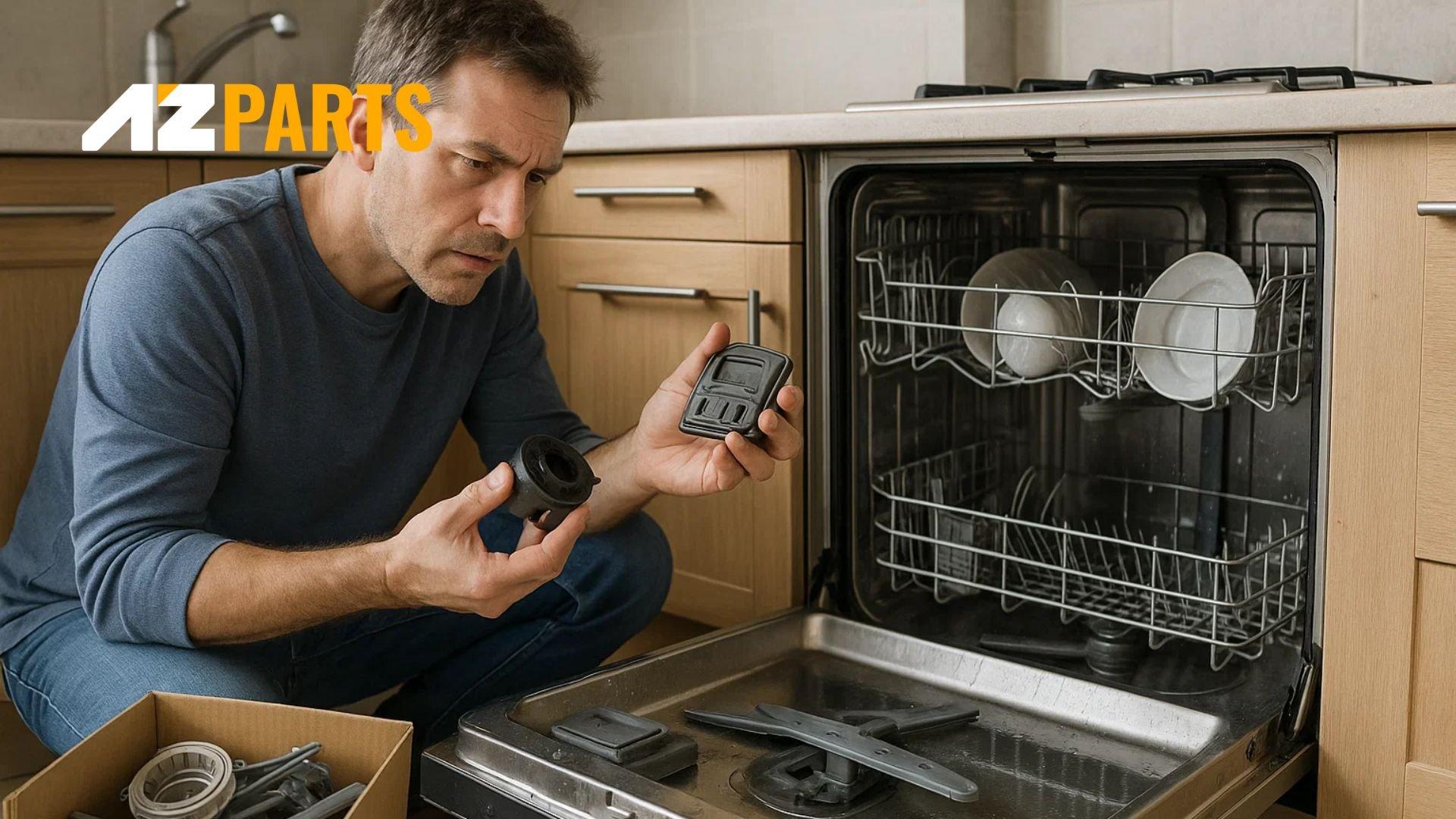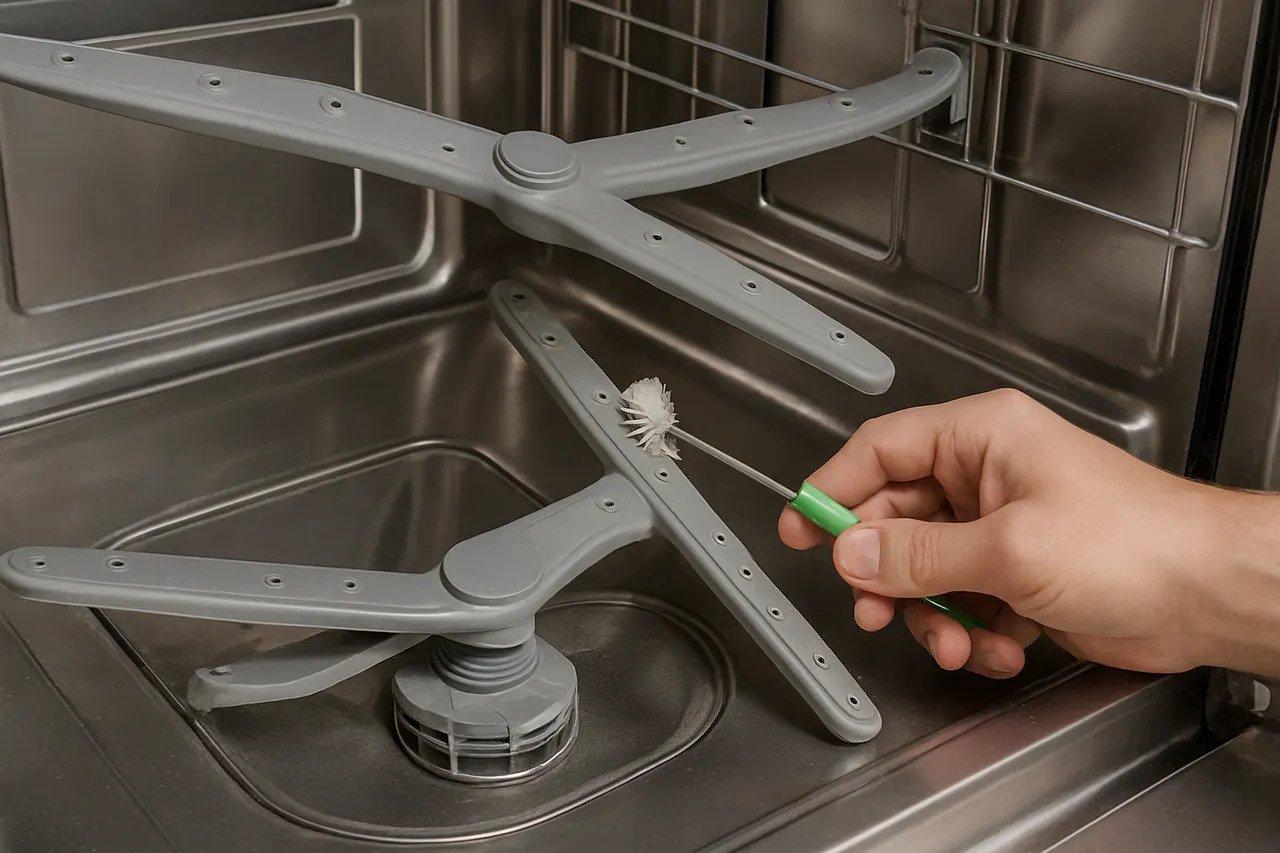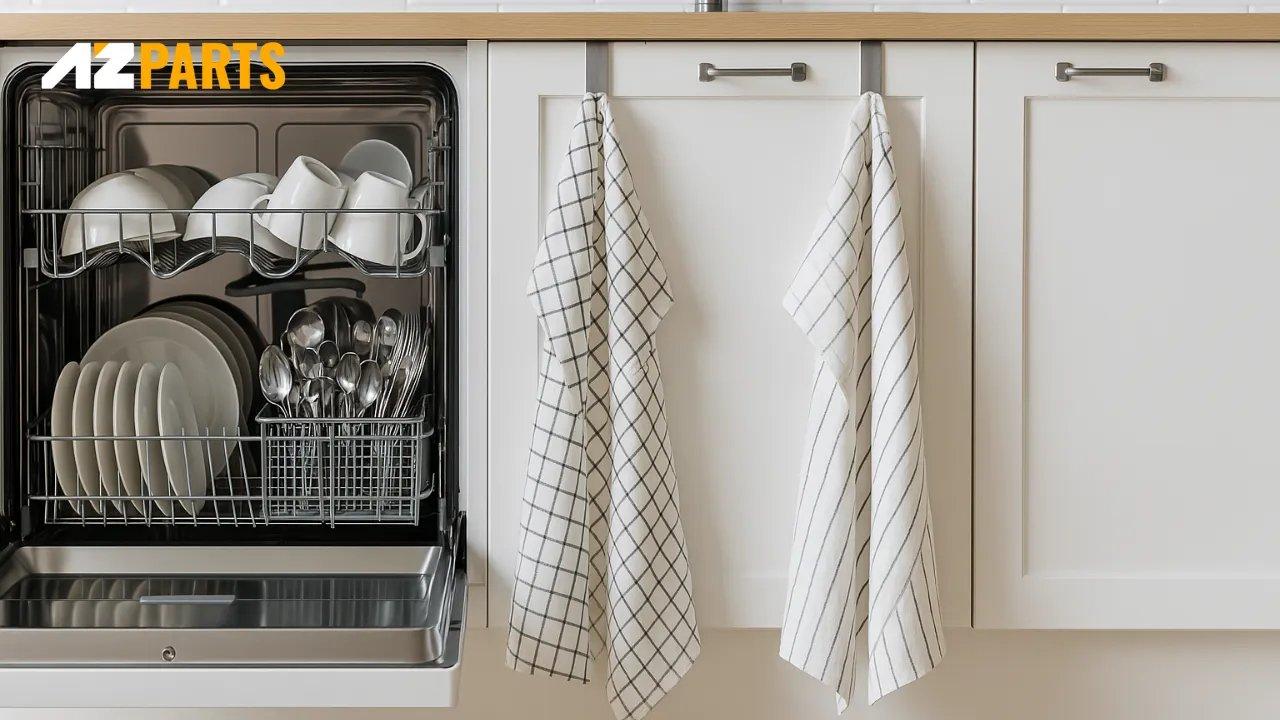Repair help
8+ Common Dishwasher Problems & How to Fix
AZparts Team
Updated on July 30, 2025
9 min read
Dishwashers make kitchen cleanup easier, but over time they can run into problems like poor drainage, failure to start, clogs, leaks, strange noises, bad odors, weak cleaning, and wet dishes after cycles. Most of these issues have simple solutions that you can handle yourself with the right knowledge and parts. AZParts provides genuine replacement components to help restore your dishwasher’s performance. By spotting dishwasher problems early and acting quickly, you can avoid costly repairs and keep your dishwasher running efficiently for longer.

1. What are the most basic problems with dishwashers?
Common dishwasher issues include poor drainage, failure to start, clogs, leaks, strange noises, odors, weak cleaning, and poor drying. These problems often result from everyday wear, lack of maintenance, or faulty parts. Understanding these basics helps you spot early signs of trouble and decide whether a quick fix or professional repair is needed. Fixing one issue can often prevent others from developing.
1.1. Dishwasher Not Draining
When your dishwasher doesn’t drain properly, it often leaves a pool of standing water at the bottom after a cycle finishes. This issue is frequently caused by a clogged filter, a blocked or kinked drain hose, a clogged garbage disposal (if connected), or a malfunctioning drain pump.
- Remove and Clean the Dishwasher Filter Remove the bottom rack and locate the cylindrical filter at the base of the tub. Take it out and rinse thoroughly under hot water to remove food debris and grease buildup.
- Check the Drain Hose for Blockages Inspect the drain hose under the sink for bends, pinches, or clogs that prevent proper water flow. Ensure the hose has a proper high loop or air gap to prevent backflow.
- Clear Garbage Disposal Obstructions If your dishwasher drains through the garbage disposal, run the disposal unit to clear any blockages that may be preventing normal drainage.
- Test the Drain Pump Function When basic cleaning doesn't work, the problem may be a malfunctioning drain pump that forces water out during each cycle. A clogged or broken pump will need replacement.
- Replace with Compatible Parts AZParts offers compatible dishwasher drain pumps for various models to restore normal drainage performance when pump replacement is needed.

Compatible drain pumps (Source: AZParts)
1.2. Dishwasher Won't Start
A dishwasher that fails to start can be caused by a few different issues, most commonly related to the power supply, door latch mechanism, or control panel:
- Power issues may stem from loose connections, tripped circuit breakers, or the need for system resets after outages.
- Door latch problems prevent operation since dishwashers only run when fully closed and securely latched - misalignment, broken parts, or debris can block proper latching.
- Control panel issues include unresponsive buttons, activated child locks, or faulty control boards that prevent normal operation.
Ensure the dishwasher is firmly plugged in and check that the circuit breaker hasn't tripped, then try the reset function or specific button combinations per your user manual. Inspect the door latch for misalignment, broken parts, or food particles blocking proper closure, cleaning the area as needed.
Check the control panel for unresponsive buttons, blinking indicators, or activated child lock features that need deactivation. If the latch is worn or the control board remains unresponsive after reset attempts, replacement parts may be necessary.
1.3. Dishwasher Is Clogged
Clogs in a dishwasher are often caused by accumulated food scraps, grease, or soap residue that build up over time. The filter is the most common source of clogs and should be cleaned regularly to maintain water flow and prevent debris from circulating during the wash. Spray arms can also get clogged, especially if the holes are blocked by food particles or mineral deposits from hard water.
To fix this, remove the spray arms and rinse them under hot water, using a brush or toothpick to clear the spray nozzles. Always scrape large food particles off dishes before placing them in the dishwasher, and avoid overloading the racks. For long-term maintenance, run a monthly cleaning cycle using dishwasher cleaner or white vinegar. If clogs persist despite regular cleaning, internal parts like the drain hose or circulation pump may need to be inspected and cleaned more thoroughly.

Spray arms can get clogged (Source: AZParts)
1.4. Dishwasher Is Leaking
Leaks typically come from the door area, water inlet, drain hose, or internal components such as the pump or tub. The door gasket is one of the most common sources of leaks - over time, this rubber seal can become cracked, brittle, or misaligned. Leaks from underneath the unit may indicate broken pump seals, cracked tubs, or loose internal hoses that require immediate attention.
How to fix:
- Inspect the door gasket carefully and clean it with warm, soapy water to remove residue that could prevent a proper seal.
- Replace the gasket if it shows signs of wear, cracks, or damage that compromise the seal.
- Check the water inlet and drain hose connections to ensure they are tight and free of cracks or loose fittings.
- For leaks coming from underneath, inspect internal components like pump seals and hoses, tightening connections or replacing damaged parts as needed.
These issues may require partial disassembly and replacement parts. AZParts carries high-quality dishwasher door gaskets, inlet valves, and other components that can help fix leaks and prevent water damage.

High-quality door gaskets (Source: AZParts)
1.5. Dishwasher Smells Bad
A closed, moist environment is ideal for odors to develop, especially when the filter is not cleaned regularly. The smell becomes more pronounced over time as bacteria multiply in the warm, humid conditions inside the dishwasher. Food particles and grease buildup around the door seal and interior walls contribute to persistent bad odors.
How to fix:
- Remove the filter and rinse it thoroughly to remove old food particles that cause odor buildup.
- Clean the spray arms and interior walls of the dishwasher, especially around the door seal where grime collects.
- Run a hot water cycle with a cup of white vinegar on the top rack or use specialized dishwasher cleaner to eliminate lingering odors.
- Always rinse off large food scraps before loading, clean the filter weekly, leave the door slightly ajar after cycles, and run monthly cleaning cycles.
1.6. Dishwasher Is Very Noisy
Grinding or rattling noises are often caused by small objects such as bones, utensils, or broken glass that have fallen into the drain area or chopper blade. Squealing or whining noises may result from worn-out bearings or seals inside the motor or pump. Rattling sounds during operation can occur when dishes are loosely loaded or when spray arms are hitting large or improperly placed items.
How to fix:
- Turn off the dishwasher, remove the bottom rack, and inspect the sump for any foreign items that may be causing grinding sounds.
- Make sure dishes are securely placed, and that the spray arms can rotate freely without obstruction from large items.
- If the dishwasher makes loud banging or knocking noises when filling or stopping, install a water hammer arrestor to resolve water pressure issues.
- Replace failing mechanical components such as motors or pumps to prevent further noise and damage to the unit.

Unusual noises coming from a dishwasher (Source: AZParts)
1.7. Dishwasher Not Cleaning Dishes Well
When dishes come out still dirty, greasy, or covered in residue, there are several possible causes to consider. Spray arms may be partially or completely blocked, preventing proper water circulation throughout the dishwasher. A dirty or clogged filter can allow food particles to recirculate, redepositing debris on dishes. Overloading the dishwasher or blocking spray arm paths, improper detergent usage, or insufficient water temperature can all affect cleaning results.
How to fix:
- Remove the spray arms and clean out the holes using a soft brush or toothpick to restore water flow.
- Clean the filter regularly to prevent food particle recirculation and maintain proper filtration.
- Avoid overloading and ensure spray arms have clear paths to reach all dishes effectively.
- Use proper detergent amount and type for your water conditions, and ensure the water heater is set to at least 120°F for optimal cleaning performance.
If all maintenance steps are followed and performance is still poor, the issue may be with a worn or broken circulation pump, spray arm assembly, or detergent dispenser. AZParts carries replacement dishwasher filters and internal cleaning components that can help restore cleaning efficiency.

Dishwasher Pump Filter Cup (Source: AZParts)
1.8. Dishwasher Not Drying Dishes
Dishes that remain wet after a full cycle often indicate a problem with the drying system or rinse aid usage. This issue occurs because rinse aid is essential for effective drying - it reduces surface tension, allowing water to slide off dish surfaces instead of forming droplets. Improper loading can also prevent drying, especially if cups or bowls are stacked in a way that traps water. Non-functional heating elements or blocked vents will keep steam inside and leave dishes damp.
How to fix:
- Make sure the rinse aid dispenser is filled and functioning properly.
- Avoid overlapping items and allow space for airflow when loading dishes.
- Check if the heating element is working correctly, as non-functional heating will leave dishes wet.
- Ensure vents that release steam during the drying process are not blocked and open properly.
- Finally, leave the door slightly open after the cycle to help moisture escape.

Dishwasher not drying dishes (Source: AZParts)
2. Common Dishwasher Problem FAQs
2.1. Is it worth repairing a dishwasher?
It depends on the age and condition of the unit. If the dishwasher is under 7 years old and the repair is minor, it’s usually worth fixing. But if repair costs are more than half the price of a new unit and the dishwasher is over 7 years old, replacement may be the better option. Newer models also offer better energy efficiency, which can save money over time.
2.2. How to test what is wrong with my dishwasher?
Troubleshooting begins with simple checks. Make sure the dishwasher is plugged in, the door is securely closed, and the control settings are correct. Run a cycle and observe any signs of trouble, such as water not filling, unusual noises, or dishes coming out dirty. Inspect key parts like the filter, spray arms, and drain hose for blockages or damage.
Many modern dishwashers include diagnostic modes or display error codes that can help identify specific faults. Refer to your user manual for model-specific testing instructions and solutions.
2.3. What is the average lifespan of a dishwasher?
A typical dishwasher lasts around 9 to 12 years with regular use and proper maintenance. The actual lifespan depends on how often it’s used, water quality in your area, and how well it’s maintained. Premium models can last up to 15 years, while lower-end models may only last 7 to 8 years. Hard water can shorten the life of internal parts due to mineral buildup. To maximize your dishwasher’s lifespan, clean it regularly, avoid overloading, and address small problems before they lead to bigger damage.
Understanding common dishwasher problems and their solutions empowers homeowners to maintain their appliances effectively and avoid costly repairs. From drainage issues and startup problems to cleaning performance and drying difficulties, most dishwasher problems have straightforward solutions when addressed promptly. Regular maintenance, proper loading techniques, and quality dishwasher parts from trusted suppliers like AZParts can significantly extend your dishwasher's lifespan and maintain optimal performance.
Learn more about other dishwasher's problems you might face:
Contact Info
Address: 8 The Green, Ste A, Dover, Delaware 19901-3618, United States
Email: support@azparts.com
Dishwasher
Further Reading
Further Reading



_1748246700.jpg&w=3840&q=75)

